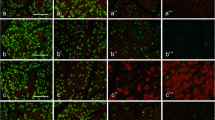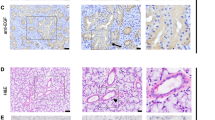Summary
The effects of the administration of thyroxine (T4) on the postnatal cytodifferentiation of granular convoluted tubule (GCT) cells of the submandibular gland (SMG) of Lewiss-Webster mice were studied by light and electron microscopy. From birth, mice of both sexes were injected daily with T4 (sc 0.4 μg/g BW) and were sacrificed 24 h after the last injection at 7, 9, 11, 14 and 21 days of age. Control mice received vehicle only. In control mice, granulated striated duct (SD) cells were first detected at 9 days and 7 days of age by light- and electron microscopy, respectively. Furthermore, a few scattered granulated SD cells were observed by light microscopy as early as day 7 in T4-treated mice of both sexes. At 21 days of age, in mice given T4, GCT cells were larger and more numerous and the Golgi apparatus, rough endoplasmic reticulum, and secretion granules were more abundant. In control mice, immunocytochemical staining for epidermal growth factor-(EGF) was first detectable at day 21 at the light- and electron-microscopic levels. However, positively stained cells were first observed in T4-treated mice by light- and electron-microscopic immunocytochemistry at 14 and 11 days of age, respectively. Moreover, in the 21-day-old T4-treated mice, the number of immunoreactive GCT cells, as well as the intensity of the staining per cell, was markedly increased as compared to controls. EGF immunostaining was restricted to GCT cells, and by immuno-electron-microscopy was only seen in apical secretory granules in granulated SD cells and GCT cells. There were no sex differences in the differentiation of the duct system under any conditions. It is concluded that T4 stimulates the biosynthesis of EGF by an acceleration of the differentiation of the GCT precursor cells to mature cells.
Similar content being viewed by others
References
Aloe L, Levi-Montalcini R (1980a) Comparative studies on testosterone and L-thyroxine effects on the synthesis of nerve growth factor in mouse submaxillary salivary glands. Exp Cell Res 125:15–22
Aloe L, Levi-Montalcini R (1980b) Enhanced differentiation of sexually dimorphic organs in L-thyroxine treated Tfm mice. Cell Tissue Res 205:19–29
Arvy L, Gabe W (1950a) Action de la thyroidectomie et des injections de thyroxine sur la glande sous-maxillaire de la souris albinos. C R Acad Sci 230:1611–1613
Barka T (1980) Biologically active polypeptides in submandibular glands. J Histochem Cytochem 28:836–859
Byyny RL, Orth DN, Cohen S (1972) Radioimmunoassay of epidermal growth factor. Endocrinology 90:1261–1266
Caramia F (1966) Ultrastructure of mouse submaxillary glands. I. Sexual differences. J Ultrastruct Res 16:505–523
Chabot JG, Walker P, Pelletier G (1982) Effect of thyroxine (T4) administration on the localization of epidermal growth factor (EGF) in mouse submaxillary gland. Program of the 58nd Annual Meeting of the American Thyroid Association, Quebec City, Canada
Chaulin-Servinière J (1942) Sur les variations de la morphologie cellulaire dans le segment tubuleux de la glande sous-maxillaire de la souris. C R Soc Biol 136:262–264
Dunn J, Wilson J (1975) Developmental study of androgen responsiveness in the submandibular gland of the mouse. Endocrinology 86:1571–1578
Dunn J, Goldstein J, Wilson J (1973) Development of increased cytoplasmic binding of androgen in the submaxillary binding of androgen in the submaxillary gland of the mouse with testicular feminization. J Biol Chem 248:7819–7825
Gresik EW (1980) Postnatal developmental changes in submandibular glands of rats and mice. J Histochem Cytochem 28:860–870
Gresik EW, Barka T (1977) Immunocytochemical localization of epidermal growth factor in mouse submandibular gland. J Histochem Cytochem 25:1027–1035
Gresik EW, Barka T (1978) Immunocytochemical localization of epidermal growth factor during the postnatal development of the submandibular gland of mouse. Am J Anat 151:1–9
Gresik EW, Barka T (1980) Precocious development of granular convoluted tubules in the mouse submandibular gland induced by thyroxine or by thyroxine and testosterone. Am J Anat 159:177–185
Gresik EW, MacRae EK (1975) The postnatal development of the sexually dimorphic duct system and of amylase activity in the submandibular glands of mice. Cell Tissue Res 157:411–422
Gresik EW, Schenkein I, van der Noen H, Barka T (1981a) Hormonal regulation of epidermal growth factor and protease in the submandibular gland of the adult mouse. Endocrinology 109:924–929
Gresik EW, van der Noen H, Barka T (1981b) Hypertrophic and hyperplastic effects of thyroxine on the submandibular gland of the mouse. Anat Rec 200:443–446
Gresik EW, Gubits RM, Barka T (1985) In situ localization of mRNA for epidermal growth factor in the submandibular gland of the mouse. J Histochem Cytochem 33:1235–1240
Hosoi K, Kobayashi S, Ueha T, Maruyama S, Sato S, Takuma T, Kumegawa M (1979) Induction of androgen-dependent protease and serous-like granules by triiodothyronine in the submandibular gland of mice with testicular feminization. J Endocrinol 83:429–434
Hosoi K, Kida T, Ueha T (1981a) Induction of various androgendependent esteroproteases (trypsin-like and chymotrypsin-like enzymes) by triiodo-L-thyronine in the submandibular glands of female mice and mice with testicular feminization. J Biochem 89:1793–1798
Hosoi K, Tanaka I, Ueha T (1981b) Induction of epidermal growth factor by tri-iodo-L-thyronine in the submandibular glands of mice with testicular feminization. J Biochem 90:267–270
Kaiho M, Nakamura T, Kumegawa M (1975) Morphological studies on the synthesis of secretory granules in convoluted tubules of mouse submandibular gland. Anat Rec 183:405–420
Kumegawa M, Takuma T, Takagi Y (1976) Precocious induction of secretory granules by hormones in convoluted tubules of mouse submandibular glands. Am J Anat 149:111–114
Van Noorden S, Heitz P, Kasper M, Pearse AGE (1977) Mouse epidermal growth factor: light and electron microscopical localization by immunocytochemical staining. Histochemistry 52:329–340
Perheentupa J, Lakshmanan I, Hoath SB, Fisher DA (1984) Hormonal modulation of mouse plasma concentration of epidermal growth factor. Acta Endocrinol (Copenh) 107:571–576
Pinkstaff C (1980) The cytology of salivary glands. Int Rev Cytol 63:141–261
Rall L, Scott J, Bell G, Crawford R, Pinschow J, Niall H, Cogklan J (1985) Mouse pre-pro-epidermal growth factor synthesis by the kidney and other tissues. Nature 313:228–231
Reynolds ES (1963) The use of lead citrate at high pH as an electron-opaque stain in electron microscopy. J Cell Biol 17:208–212
Roth J, Bendayan M, Orci L (1978) Ultrastructural localization of intracellular antigens by the use of protein A-gold complex. J Histochem Cytochem 26:1074–1081
Steidler NE, Reade PC (1982) An immunohistochemical and histological study of the influence of the testes and adrenal glands on epidermal growth factor-containing cells in the submandibular salivary glands of male mice. J Anat 135:413–421
Sternberger L (1974) Immunocytochemistry, Prentice-Hall Inc., Englewood Cliffs, N.J., p 246
Takuma T, Kumegawa M (1979) Regulation of trypsin-like esteroprotease synthesis by 5-α-dihydrotestosterone and triiodothyronine in mouse submandibular gland. Biochim Biophys Acta 564:335–341
Takuma T, Tanemura T, Hosoda S, Kumegawa M (1978) Effects of thyroxine and 5-α-dihydrotestosterone on the activities of various enzymes in the mouse submandibular gland. Biochim Biophys Acta 541:143–149
Tanaka T, Gresik EW, Barka T (1981) Epidermal growth factor and renin in mouse submandibular glands. J Histochem Cytochem 29:1229–1231
Turkington R, Males J, Cohen S (1971) Synthesis and storage of epithelial-epidermal growth factor in submandibular gland. Cancer Res 31:252–256
Verhoeven G, Wilson J (1976) Cytosol androgen binding in submandibular gland and kidney of the normal mouse and the mouse with testicular feminization. Endocrinology 99:79–92
Walker P (1982) The mouse submaxillary gland: a model for the study of hormonally dependent growth factors. J Endocrinol Invest 5:183–196
Walker P, Dussault JH (1982) Thyroxine (T4) increases submaxillary gland (SMG) nerve growth factor (NGF) and epidermal growth factor (EGF) synthesis in neonatal mice. Program of the 64nd Annual Meeting of the Endocrine Society, San Francisco, p 182
Walker P, Weichsel ME Jr, Guo SM, Fisher DA (1980) Radioimmunoassay for mouse nerve growth factor (NGF). Effects of thyroxine administration on tissue NGF levels. Brain Res 186:331–341
Walker P, Weichsel ME Jr, Hoath SB, Poland RE, Fisher DA (1981) Effect of thyroxine, testosterone and corticosterone on nerve growth factor (NGF) and epidermal growth factor (EGF) concentrations in adult female mouse submaxillary gland: dissociation of NGF and EGF responses. Endocrinology 109:582–587
Walker P, Coulombe P, Dussault JH (1982a) Time- and dose- dependent effect of triiodothyronine on submaxillary gland epidermal growth factor concentration in adult female mice. Endocrinology 111:1133–1139
Walker P, Weichsel ME Jr, Eveleth D, Fisher DA (1982b) Ontogenesis of nerve growth factor and epidermal growth factor in submaxillary glands and nerve growth factor in brains of immature male mice: correlation with ontogenesis of serum levels of thyroid hormones. Pediatr Res 16:520–524
Watson ML (1958) Staining of tissue sections for electron microscopy with heavy metals. J Biophys Biochem Cytol 4:475–478
Watson AY, Radie K, McCarthy M, Larsen PR, Murphy RA (1982) Thyroxine reverses deficits of nerve growth factor and epidermal growth factor in submandibular glands of mice with muscular dystrophy. Endocrinology 110:1392–1401
Wilson CM, Myhre MJ, Reynolds RC, Wilson JD (1982) Regulation of mouse submaxillary gland renin by thyroxine. Endocrinology 110:982–989
Author information
Authors and Affiliations
Additional information
Supported in part by grant no. MT-5730 from the Medical Research Council of Canada
Holder of a fellowship from the Medical Research Council of Canada
Scholar of the Fonds de la Recherche en Santé du Québec
Rights and permissions
About this article
Cite this article
Chabot, J.G., Walker, P. & Pelletier, G. Thyroxine accelerates the differentiation of granular convoluted tubule cells and the appearance of epidermal growth factor in the submandibular gland of the neonatal mouse. Cell Tissue Res. 248, 351–358 (1987). https://doi.org/10.1007/BF00218202
Accepted:
Issue Date:
DOI: https://doi.org/10.1007/BF00218202




